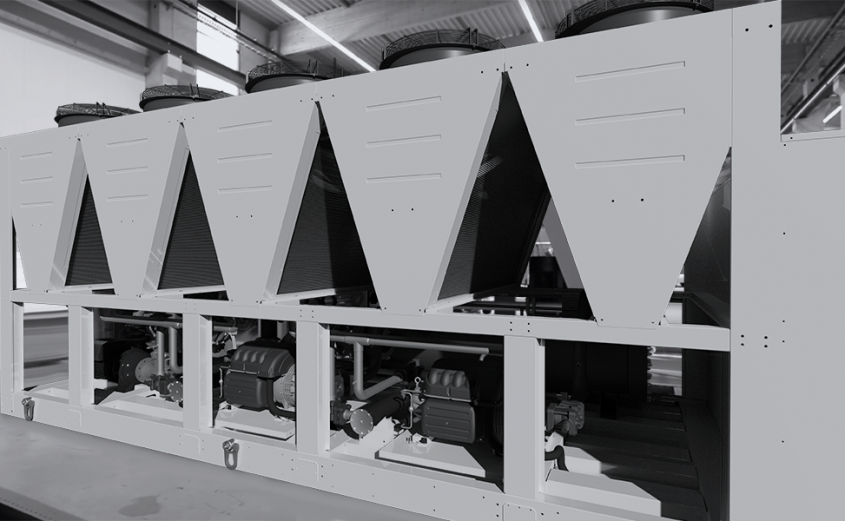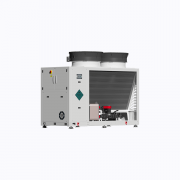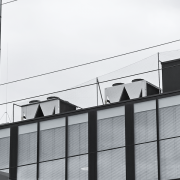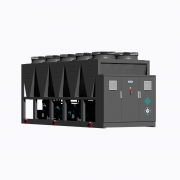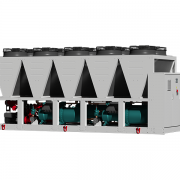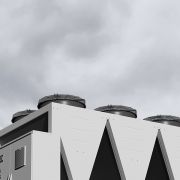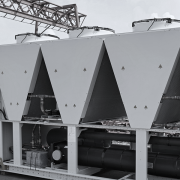Cutting energy costs with free cooling chillers
Free Cooling Concept
Free cooling is a method of cooling by using ambient air rather than performing the refrigeration cycle with, e.g., with a chiller. Many cooling systems engaged for air conditioning or industrial cooling require chilled water throughout the year. During cold seasons, ambient air is cool enough, colder than the supply chilled water setpoint, and mechanical cooling with the chiller’s compressors can be replaced with the free cooling operation. Even in warm climates, free cooling can produce energy savings, as fan motors consume much less energy than compressors.
Overwhelmingly, free cooling is used in airborne systems with water cooling coils installed outdoors, e.g., in-built into a chiller forming a water circuit between the plant water circuit and refrigeration circuit of the chiller (a free cooling chiller). When ambient temperature falls down enough, plant water, before (or instead) entering the chiller’s evaporator, started circulating through a free cooling circuit and cooled down by ambient air drawing through the cooling coils by means of fans.
The higher the ambient temperature at which free cooling is engaged, the greater the energy savings it can deliver. Transition to free cooling operation depends on the factors like:
- Plant water supply temperature
- Efficiency of the free cooling coils
- Efficiency of control algorithms
Estimation of Energy Savings
When selecting a free cooling chiller, the payback period can be roughly estimated based on annual air temperatures at the installation site and projected plant water temperatures. Free cooling operation time can be calculated as the number of hours when the ambient temperature is lower than the supply water temperature of the chiller minus a delta – typically from 3K to 7K. However, at this point, mechanical cooling is still engaged – until the moment when the ambient temperature will fall down enough for a free cooling system to serve full cooling demand.
The efficiency of the free cooling system under given operation conditions (ambient air and supply water temperatures), therefore, depends on:
- Control logic used
- Free cooling coils’ performance
In order to reduce operating costs to a minimum, Kaltra implements both approaches, with advanced chiller controls and high-performance cooling coils.
Free Cooling Control
Kaltra offers a fully integrated free cooling system with a control logic with advanced, predictive algorithms to optimize the functioning of its free cooling chillers. The software continuously monitors the outside ambient temperature, as well as supply and return plant water temperatures, and directs return water through the free cooling coils, regulating the flow using a three-way modulating valve, and unloads the compressors accordingly.
With the increase of free cooling effect, the system continues to unload compressors and finally puts them in standby mode as soon as the full capacity is provided by a free cooling system. At partial or full mechanical cooling, head pressure is precisely controlled by adjusting the speed of the fans equipped with EC-motors. At low ambients, the fan speed is controlled to maintain the required water temperature, thus optimizing the energy savings.
Advanced control algorithms best make use of free cooling potential while preventing short-cycling of the free cooling system and compressors.
Cooling Coils
Opportunities for free cooling also rise with improvements in the efficiency of air-to-water heat exchangers: the more efficient the cooling coil, the lower is temperature delta between ambient air and plant water possible; the higher the capacity of coils, under the higher air temperature at which 100% free cooling is available.
Kaltra uniquely had adopted microchannel heat exchangers as free cooling coils in its chillers due to the benefits this technology delivers:
- Minimized fan power. As free cooling coils are located in front of the condenser coils, additional air resistance is created. Microchannel coils feature generate low airside pressure drop, contributing to lowest fan power consumption
- Higher heat transfer rates maximizing the performance to achieve full capacity by the free cooling system at higher ambient temperatures
- Low waterside pressure resistance contributing to less required pump power
- Simple and easy cleaning procedure to maintain coil performance at the maximum
These beneficial aspects of microchannel coils extensively amplify the efficiency of the free cooling system integrated into our chillers.
Coupled with, the following aspects must be taken into consideration:
- As microchannel tubes feature ports of a few millimeter diameters, plant water must be clean of contaminants to avoid blocking of microchannels.
- Under some circumstances (e.g., low glycol concentration), corrosion inhibitors are recommended to add.
Conclusion: Pros And Cons of Free Cooling Chillers
- A free-cooling chiller provides effective cooling by eliminating compressor operation at low ambient conditions, saving considerable amounts of energy associated with mechanical cooling during the cold periods
- Free cooling chillers are well suitable for chilled water production in extremely cold climates where low ambient temperatures constraining the use of mechanical cooling
- In hot climates, free cooling chiller produces no (significant) savings
- Free cooling chillers are not suitable or give the only a small economy when used with low plant water temperatures
- A glycol mixture shall be used for the primary plant water circuit to avoid freezing in low ambient conditions
Free cooling chillers are a good energy-saving alternative for mild climates, especially when plant water temperatures are high. They are perfect for applications like data center cooling, air conditioning in buildings and can be effectively combined with non-free cooling chillers in a number of process cooling applications, and irreplaceable for 365-day operation in cold climates.
Figure 1: Free cooling opportunities in different climate zones
Prior to adopting free cooling chillers, it is necessary to assess if their use will contribute to adequate energy savings – based on energy analysis and comparative study performed for given requirements and climate conditions, and Kaltra technicians can assist customers with this task.

